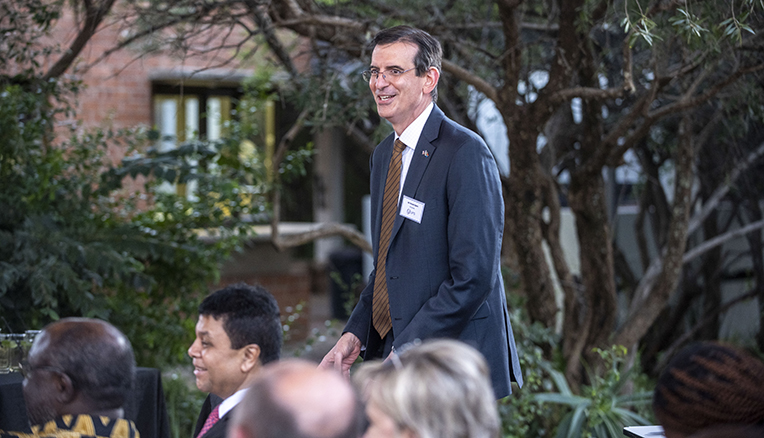According to the Internationalisation Strategy of the University of the Free State (UFS), internationalisation has been accepted globally and in South Africa as one of the critical processes advancing the core business of universities. It is also considered
one of the critical drivers of institutional transformation.
Globally, the UFS has numerous collaborations. In North America alone – according to Scival data for the period 2017 to 2020 – the university has collaborated with 427 institutions in the North American region.
Building capacity
One of the UFS’ key strategic partners on that continent is the United States. Recently (23 and 24 March 2022), the US Consul General,
Mr Vincent Spera, together with
Prof Jesse Lutabingwa, Associate Vice-Chancellor of the
Appalachian State University in North Carolina, visited the UFS and spent time on both the Qwaqwa and Bloemfontein Campuses.
In Qwaqwa, engagements took place with staff involved in the Mountain-to-Mountain Research Programme, a collaboration between the UFS and three United States of America (US) universities, funded by a R8 million grant from the US Embassy in South Africa.
The funding covers, among other initiatives, the two master’s degree programmes in underdeveloped niche areas, meteorological weather stations, leadership capacity building for black women in academia, and doctoral research projects.
The delegation also had a round-table conversation with an ‘Emerging Black Female Academics cohort’ established with funding from the aforementioned US Embassy grant.
Different perspectives
With the aim of showcasing and celebrating the collaboration between US stakeholders and the UFS, specifically in astrophysical research, the group engaged with a cohort of scientists at the
Boyden Observatory in Bloemfontein during a tour of the observatory and its telescopes.
Prof Francis Petersen, Rector and Vice-Chancellor of the UFS, and
Dr Khotso Mokhele, former UFS Chancellor and non-Executive Director of MTN, Chairman of AECI Limited, and President of the Hans Merensky Foundation, accompanied the US delegates. Dr Mokhele, a former President
of the National Research Foundation, and a supporter of the work being done by the UFS, continues to play a role in promoting science in order to change people’s lives.
“Through our partnership with universities in the US, we are not only celebrating knowledge exchange, but also different perspectives that will contribute to a better university,” says Prof Petersen.
Specifically referring to the Boyden Observatory, Prof Petersen noted the astronomical heritage between the UFS and the United States. In the late 1920s, two American universities established two astronomical observatories in central South Africa. In
1928, the
University of Michigan founded the Lamont-Hussey Observatory (home to the biggest refracting telescope in the Southern Hemisphere) on
Naval Hill in Bloemfontein, and in 1927,
Harvard University relocated the Boyden Observatory from Peru to Maselspoort, 25 km from Bloemfontein. These two historic observatories now resort under the UFS.

(According to Mr Vincent Spera, the US Mission is proud to be playing a role in supporting higher education in South Africa through grants,
scholarships, and exchange programmes. Photo: Francois van Vuuren)
Cultivating ties
According to
Prof Matie Hoffman,
Associate Professor in the UFS
Department of Physics, Boyden is
one of the most accessible optical observatories in the world. With its combination of fascinating history, exciting research projects, and its location on a beautiful hill next to a river, the observatory is an extremely valuable historical, educational,
and public facility. In 1955, Boyden became the first internationally managed observatory in the world. The observatory was under international management until 1976.
The Two Observatories Project (Boyden and Naval Hill) cultivates ties with several US educational and cultural bodies, leading to increased opportunities between the institutions. Relationships exist, among others, with the
American Museum of Natural History (AMNH), Harvard University, the University of Michigan, and the Utah Valley University. Apart from the observatory’s long history with these US institutions, it has
also hosted delegates from NASA and other astrophysics intuitions in the past.
Prof Petersen states that he would like to see ties between the institutions strengthened – through different projects – to contribute to capacity development.
Representing the US, Mr Spera states that it is fulfilling to celebrate a long and meaningful relationship with the UFS. “The US Mission is proud to be playing a role in supporting higher education in South Africa through grants, scholarships, and
exchange programmes. Especially meaningful is the depth of the relationship with the UFS; a relationship where the real value is in the partnerships that exist between the people of the two countries. One of our key goals is to connect South Africans
and Americans for the betterment of both countries.”
Through our partnership with universities in the US, we are not only celebrating knowledge exchange, but also different perspectives that will contribute to a better university. – Prof Francis Petersen.
Celebrating successes
Prof Lutabingwa says the Appalachian State University takes its relationship with the UFS very seriously. He celebrates this successful partnership of more than 14 years marked by trust and honesty. It encompasses research, learning and teaching, and
capacity development activities on all UFS campuses. Examples of collaborative activities include a virtual exchange programme coordinated for the UFS by Prof Lynette Jacobs from the South Campus, and research cooperation in the Faculty of Education,
which is championed by Dr Bekithemba Dube on the Qwaqwa Campus.
The work with Fulbright Professor
Richard Gray from the Appalachian State University – who has developed a spectrograph for the large
1,52 m telescope at Boyden – is another prime example of the work being done between the two institutions. According to Prof Gray, whose involvement is valuable for astrophysics research at the UFS, the combined polarimetric-spectroscopic capability
in one single instrument is unique. Combined with the fact that it is hosted on a historic research instrument that is utilised and maintained exclusively by the
UFS Astronomy Group in the Department of Physics, gives this group a competitive edge over most international astronomy
groups.